Themed collection Structural Design of Coordination Polymers

Front cover
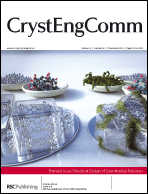
Inside front cover
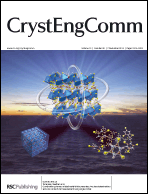
Back cover

Contents list
Structural design of coordination polymers
Welcome to this CrystEngComm themed issue on the structural design of coordination polymers.

CrystEngComm, 2013,15, 9237-9238
https://doi.org/10.1039/C3CE90156D
Activation of metal–organic framework materials
This work highlights the current strategies used to activate metal–organic framework materials.
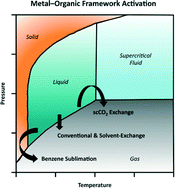
CrystEngComm, 2013,15, 9258-9264
https://doi.org/10.1039/C3CE41232F
Metal–organic frameworks (MOFs) based on mixed linker systems: structural diversities towards functional materials
Mixed linkers based frameworks are structurally or topologically versatile and show excellent gas storage and separation properties. Multiple functionalities can be assembled in a single framework system and properties such as molecular sensing, catalysis, magnetism etc. can be tuned to a greater extent.
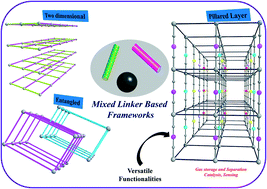
CrystEngComm, 2013,15, 9276-9295
https://doi.org/10.1039/C3CE41438H
Fascinating chemistry or frustrating unpredictability: observations in crystal engineering of metal–organic frameworks
Coordination chemistry around the tectonic units of MOFs and additional interplay of solvent and anionic species rule out structure prediction.
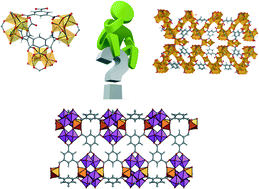
CrystEngComm, 2013,15, 9249-9257
https://doi.org/10.1039/C3CE41241E
Substitution at the metal center of coordination polymers in single-crystal-to-single-crystal (SC-SC) transformation
Reactions at the metal centers of PCPs by other guest molecules, in a single-crystal-to-single-crystal mode, can offer ways to modify the coordination space for directing multiple small molecules cooperatively and enhance MOFs' functionalities.
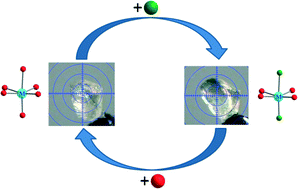
CrystEngComm, 2013,15, 9239-9248
https://doi.org/10.1039/C3CE41257A
Application of W–Cu–S-based secondary building units in functional metal–organic frameworks
This article highlights the recent advances and challenges on the structures and properties of W–Cu–S-based cluster polymers.
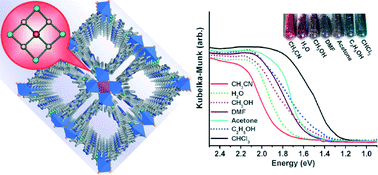
CrystEngComm, 2013,15, 9265-9275
https://doi.org/10.1039/C3CE40992A
Birefringent, emissive coordination polymers incorporating bis(benzimidazole)pyridine as an anisotropic building block
A series of coordination polymers incorporating lanthanide centres, [Au(CN)2]− units and the highly anisotropic building block bis(benzimidazole)pyridine have been prepared. Setting a new benchmark for high birefringence in coordination polymers, these materials are also highly emissive.
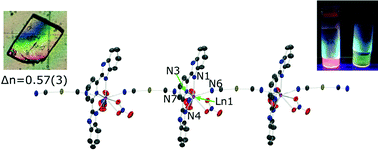
CrystEngComm, 2013,15, 9387-9393
https://doi.org/10.1039/C3CE41556B
Syntheses of two imidazolate-4-amide-5-imidate linker-based hexagonal metal–organic frameworks with flexible ethoxy substituent
A rare example of an in situ linker generation and the formation of two MOFs (IFP-9 and -10) are synthesized under solvothermal condition. Gas-sorption behavior of both materials showed the hysteretic isotherms, indicating the flexible MOFs.
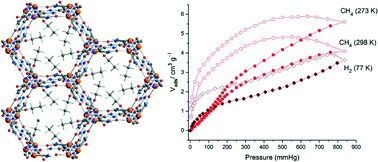
CrystEngComm, 2013,15, 9394-9399
https://doi.org/10.1039/C3CE41632A
Directed formation of tri-connected Cu(I) coordination polymers
The formation of copper(I) coordination polymers featuring a 1D staircase and a 2D polycyclohexane framework is controlled by steric factors.
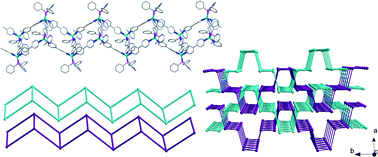
CrystEngComm, 2013,15, 9372-9376
https://doi.org/10.1039/C3CE41101J
Correlating structure and chemistry through simultaneous in situ pair distribution function and infrared spectroscopy measurements
The coupled chemical and structural insights provided by combining PDF and IR measurements resolve the influence of different types of guests in a nanoporous Prussian blue analogue.
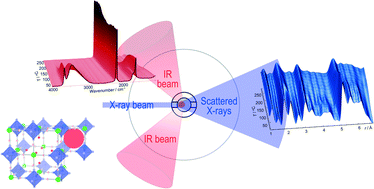
CrystEngComm, 2013,15, 9377-9381
https://doi.org/10.1039/C3CE41458B
Metal–organic frameworks as potential multi-carriers of drugs
The metal–organic framework CPO-27-Ni can act as a releasing agent of multiple non-conventional anticancer drugs, namely, RAPTA-C and NO.
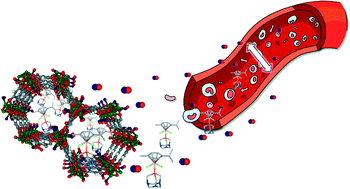
CrystEngComm, 2013,15, 9364-9367
https://doi.org/10.1039/C3CE41289J
Alternative synthetic methodology for amide formation in the post-synthetic modification of Ti-MIL125-NH2
Ti-MIL125-NH2 is post-synthetically modified utilising a novel and mild amide synthesis.
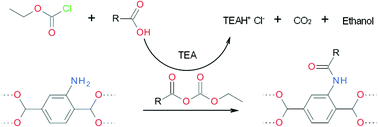
CrystEngComm, 2013,15, 9368-9371
https://doi.org/10.1039/C3CE41332B
In situ growth of luminescent MOF thin films of Sr/Eu(II)-imidazolate on functionalized nanostructured alumina
Highly luminescent dense frameworks 3∞[Sr1−xEuxIm2], x = 0–1, were used for in situ growth on nanoporous AAO membranes. Initial growth inside the AAO channels can be observed before a closed layer is formed.
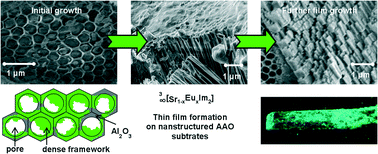
CrystEngComm, 2013,15, 9382-9386
https://doi.org/10.1039/C3CE41087K
Morphological diversity of Mn(III) metalloporphyrin-based nano- and microsized CPAs assembled via kinetic and thermodynamic controls and their application in heterogeneous catalysis
A series of narrowly dispersed nano- and microsized CPAs has been prepared from a (porphyrin)Mn(III) biscarboxylic acid and Co(OAc)2.
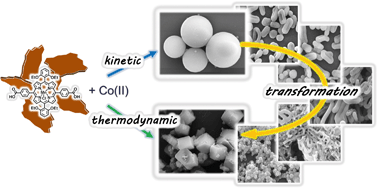
CrystEngComm, 2013,15, 9360-9363
https://doi.org/10.1039/C3CE41072B
Encapsulation of polyoxometalates within layered metal–organic frameworks with topological and pore control
Organic links of varied structure metrics and functionalities connect with Cu2(COO)4 clusters to afford layered metal–organic frameworks incorporated with polyoxometalates.
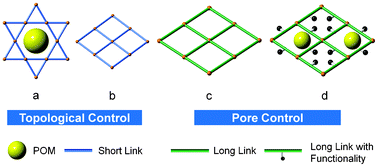
CrystEngComm, 2013,15, 9340-9343
https://doi.org/10.1039/C3CE41136B
Direct observations of the MOF (UiO-66) structure by transmission electron microscopy
Combining electron diffraction tomography and high resolution transmission electron microscopy for structure determinations of metal organic frameworks.
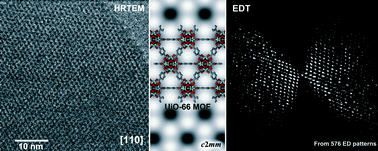
CrystEngComm, 2013,15, 9356-9359
https://doi.org/10.1039/C3CE41122B
[2 + 2] Cycloaddition reaction as a tool to monitor the formation of thermodynamically stable ladder coordination polymers
A linear coordination polymer transformed to a sheet by the loss of coordinated DMF, which rearranged to a ladder polymer when the desolvated single crystals were ground to powder.
![Graphical abstract: [2 + 2] Cycloaddition reaction as a tool to monitor the formation of thermodynamically stable ladder coordination polymers](/en/Image/Get?imageInfo.ImageType=GA&imageInfo.ImageIdentifier.ManuscriptID=C3CE41176A&imageInfo.ImageIdentifier.Year=2013)
CrystEngComm, 2013,15, 9324-9327
https://doi.org/10.1039/C3CE41176A
A highly porous agw-type metal–organic framework and its CO2 and H2 adsorption capacity
An unsymmetrical tricarboxylate ligand with linking alkyne moiety has been used to construct a highly porous metal–organic framework with agw topology, exhibiting a high BET surface area of 3337.0 m2 g−1, a large capacity of CO2 (21.2 mmol g−1 at 298 K and 20 bar) and a good H2 adsorption (5.8 wt% at 77 K and 20 bar).
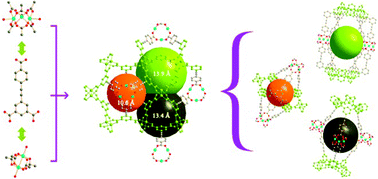
CrystEngComm, 2013,15, 9348-9351
https://doi.org/10.1039/C3CE41119B
A highly porous interpenetrated MOF-5-type network based on bipyrazolate linkers
In spite of interpenetration, the novel pcu-a topology cobalt(II) MOF-5-type metal organic framework exhibits a highly accessible porous structure.
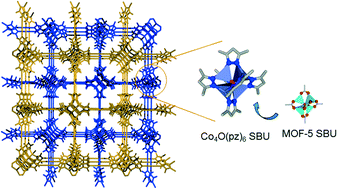
CrystEngComm, 2013,15, 9352-9355
https://doi.org/10.1039/C3CE41339J
Edge-directed assembly of a 3D 2p–3d heterometallic metal–organic framework based on a cubic Co8(TzDC)12 cage
A 3D 2p–3d heterometallic metal–organic framework based on anovel cubic-like Co8L12 cages has been synthesized and investigated.
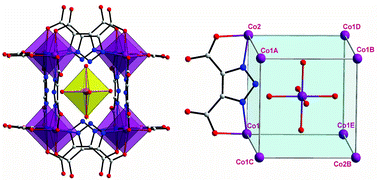
CrystEngComm, 2013,15, 9344-9347
https://doi.org/10.1039/C3CE41117F
Porous Fe2O3 nanocubes derived from MOFs for highly reversible lithium storage
Porous Fe2O3 nanocubes composed of ultrafine Fe2O3 nanoparticles have been derived from Fe-containing metal–organic frameworks (MOFs), showing promising electrochemical lithium storage properties.
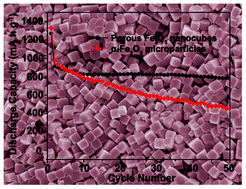
CrystEngComm, 2013,15, 9332-9335
https://doi.org/10.1039/C3CE40996A
A mesoporous lanthanide–organic framework constructed from a dendritic hexacarboxylate with cages of 2.4 nm
A novel mesoporous lanthanide metal–organic framework with hey topology was constructed from a dendritic hexacarboxylate, and the permanent porosity was established by gas sorption isotherms.
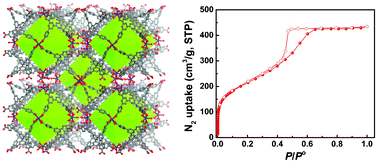
CrystEngComm, 2013,15, 9328-9331
https://doi.org/10.1039/C3CE41062E
Design of microporous mixed zinc–nickel triazolate metal–organic frameworks with functional ligands
We prepared two new Zn–Ni MOFs based on either triazolate or diaminotriazolate in which the functional ligands play a major role for both the photoluminescent and the gas sorption properties.
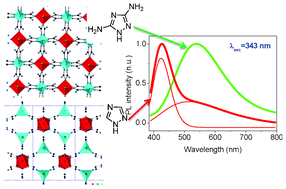
CrystEngComm, 2013,15, 9336-9339
https://doi.org/10.1039/C3CE41260A
Additive-mediated size control of MOF nanoparticles
A fast synthesis approach toward sub-60 nm sized MOF nanoparticles was developed by employing auxiliary additives.
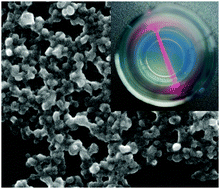
CrystEngComm, 2013,15, 9296-9300
https://doi.org/10.1039/C3CE41152D
Counteranion-directed structural consequences in silver–adenine N-oxide complexes
This communication explores the structural consequences of N9-propyladenine N1-oxide by varying five different counteranions in silver salts.
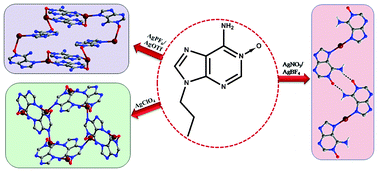
CrystEngComm, 2013,15, 9316-9319
https://doi.org/10.1039/C3CE41164H
Two rare indium-based porous metal–metalloporphyrin frameworks exhibiting interesting CO2 uptake
Two rare indium-based porous metal–metalloporphyrin frameworks with pts topology were constructed based upon two custom-designed porphyrin ligands and they exhibited interesting CO2 adsorption properties.
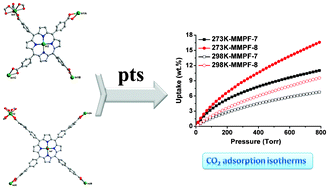
CrystEngComm, 2013,15, 9320-9323
https://doi.org/10.1039/C3CE41090K
Solvent -free synthesis of supported ZIF-8 films and patterns through transformation of deposited zinc oxide precursors
ZIF-8 thin films and patterns were obtained through the solvent-free reaction of deposited ZnO films with melted 2-methylimidazole.
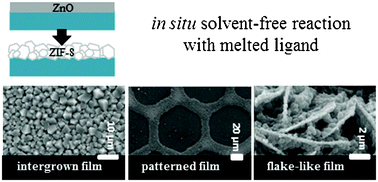
CrystEngComm, 2013,15, 9308-9311
https://doi.org/10.1039/C3CE41025K
Self-assembly of a chiral three-dimensional manganese(II)–copper(II) coordination polymer with a double helical architecture
We report the first example of mixed oxalato/oxamato-based chiral 3D MOP with an open-framework structure built up from double helical MnIICuII ferrimagnetic chains.
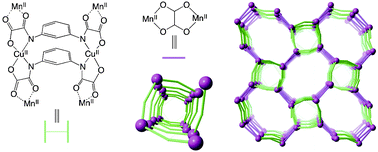
CrystEngComm, 2013,15, 9312-9315
https://doi.org/10.1039/C3CE41022F
The influence of nitro groups on the topology and gas sorption property of extended Zn(II)-paddlewheel MOFs
The work presents the incorporation of two nitro-functionalized biphenyldicarboxylic acid ligands into Zn(II)-paddlewheel MOFs and a Zn(II)-based 2D coordination polymer.
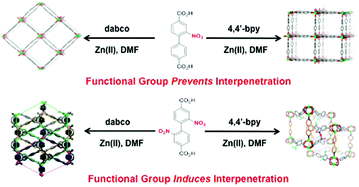
CrystEngComm, 2013,15, 9304-9307
https://doi.org/10.1039/C3CE41124A
A molybdenum diphosphonate network structure exhibiting reversible dehydration and selective uptake of methanol
A new molybdenum diphosphonate network structure has been prepared and structurally characterised. It shows reversible dehydration, which occurs with a structural change, and the dehydrated material is able to adsorb methanol but not ethanol.
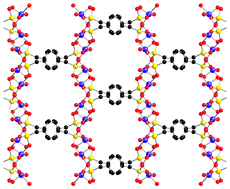
CrystEngComm, 2013,15, 9301-9303
https://doi.org/10.1039/C3CE40484F
Polynuclear coordination compounds: a magnetostructural study of ferromagnetically coupled Ni4O4 cubane core motif
A series of tetranuclear nickel(II) complexes [NiII4L14(H2O)4] (1), [NiII4L24(MeOH)3(H2O)] (2), [NiII4L24(H2O)4] (3), [NiII4L34(MeOH)4] (4), [NiII4L44(MeOH)4] (5) have been synthesized by employing alkoxo–phenoxo ligands and magnetostructural analysis has been performed.
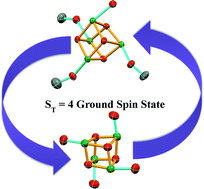
CrystEngComm, 2014,16, 2371-2383
https://doi.org/10.1039/C3CE41125G
Photoluminescent layered lanthanide–organic framework based on a novel trifluorotriphosphonate organic linker
A series of photoluminescent fluorinated lanthanide-organic frameworks, [Ln(H3tftp)(H2O)], has been successfully prepared using novel H6tftp and Ln3+ cations.

CrystEngComm, 2014,16, 344-358
https://doi.org/10.1039/C3CE41482E
Metal–organic frameworks from novel flexible triptycene- and pentiptycene-based ligands
Four distinct iptycene-containing metal–organic frameworks (MOFs) were synthesized and characterized using two new organic ligands.
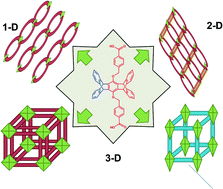
CrystEngComm, 2013,15, 9811-9819
https://doi.org/10.1039/C3CE41459K
Copper(II) coordination polymers of imdc− (H2imdc+ = the 1,3-bis(carboxymethyl)imidazolium cation): unusual sheet interpenetration and an unexpected single crystal-to-single crystal transformation
A remarkable single crystal-to-single crystal transformation and an unusual mode of interpenetration are reported as part of an investigation into coordination polymers formed when Cu(II) centres are linked by singly-charged dicarboxylate ligands.
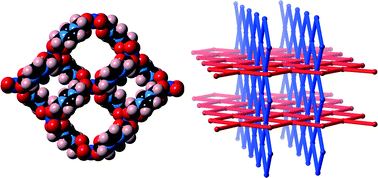
CrystEngComm, 2013,15, 9729-9737
https://doi.org/10.1039/C3CE41226A
Post-synthetic incorporation of nickel into CPO-27(Mg) to give materials with enhanced permanent porosity
Post-synthetic modification of CPO-27(Mg) (Mg-MOF-74) with Ni2+ gives cation exchange and materials with high permanent porosity upon thermal activation.
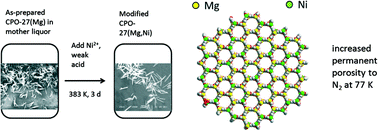
CrystEngComm, 2013,15, 9779-9786
https://doi.org/10.1039/C3CE41228H
Metal–organic gels and coordination networks of pyridine-3,5-bis(1-methyl-benzimidazole-2-yl) and metal halides: self sustainability, mechano, chemical responsiveness and gas and dye sorptions
The metal–organic gels were found to contain intertwined fibrous structures which are stabilized by weak interactions such as coordination, hydrogen bonding and π–π interactions and also exhibit good self sustainability, dye and gas absorption properties.
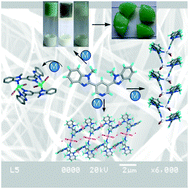
CrystEngComm, 2013,15, 9769-9778
https://doi.org/10.1039/C3CE41501E
Vapor phase detection of nitroaromatic and nitroaliphatic explosives by fluorescence active metal–organic frameworks
A series of zinc-based fluorescence active MOFs (or FAMs) built on prototypical paddle-wheel secondary building unit (SBU) act as effective sensors for the vapor phase detection of electron-deficient and electron-rich aromatics as well as nitroaliphatics.
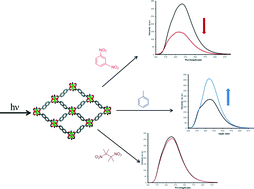
CrystEngComm, 2013,15, 9745-9750
https://doi.org/10.1039/C3CE41680A
Extending the supramolecular synthon concept in flexible polyaminocarboxylate based coordination polymers
The utility of the supramolecular synthon concept in understanding the aggregation mechanism in flexible polyaminocarboxylate based CPs is illustrated.
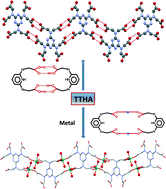
CrystEngComm, 2013,15, 9787-9797
https://doi.org/10.1039/C3CE41067F
Two cadmium(II) coordination polymers constructed by carboxylate and pyridine mixed ligands: synthesis, structure and luminescent properties
Temperature induced structural variation was demonstrated in two new cadmium(II) coordination polymers, {[Cd(BTG)(bpy)(H2O)]·0.5glycol·H2O}n (1) and {[Cd6(BTB)4(byp)4.5(glycol)]·9H2O}n (2).
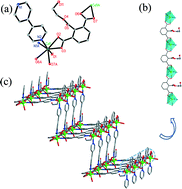
CrystEngComm, 2013,15, 9738-9744
https://doi.org/10.1039/C3CE41073K
Host–guest key–lock hydrogen-bonding interactions: a rare case in the design of a V-shaped polycarboxylate Ni(II)-based chiral coordination polymer
Instead of involving chiral ligands, chiral solvents, and chiral promoters, a “host–guest key–lock” model is demonstrated with four simultaneous pairs of C–H⋯F, C–H⋯O, and C–H⋯N hydrogen-bondings to generate a chiral coordination polymer.
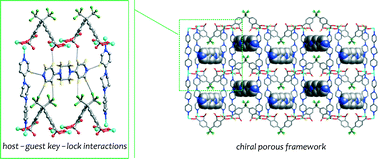
CrystEngComm, 2013,15, 9798-9810
https://doi.org/10.1039/C3CE41047A
Assembly of Ag(I) coordination polymers from a tripyridyl-ester ligand: effects of counter anion, ligand conformation and π–π interaction on non-interpenetrating 2D → 3D dimension increase
Four Ag(I)-MOFs with diverse pore shape have been assembled by coordination bonds, π–π interactions and silver–oxygen interactions via different counterions.
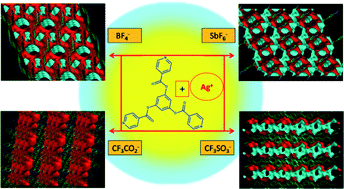
CrystEngComm, 2013,15, 9751-9756
https://doi.org/10.1039/C3CE41071D
Chelation-driven fluorescence deactivation in three alkali earth metal MOFs containing 2,2′-dihydroxybiphenyl-4,4′-dicarboxylate
Three new metal–organic frameworks (MOFs) have been synthesised from alkali earth metal ions of increasing ionic radii (Mg, Ca and Sr) and 2,2′-dihydroxybiphenyl-4,4′-dicarboxylic acid (H4diol).
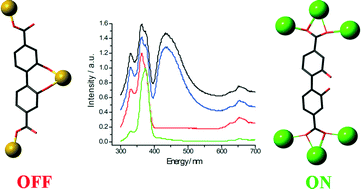
CrystEngComm, 2013,15, 9722-9728
https://doi.org/10.1039/C3CE41253A
Selective gas adsorption and unique phase transition properties in a stable magnesium metal-organic framework constructed from infinite metal chains
A stable 3D Magnesium MOF resembles the topology of MIL-53. It can selectively adsorb CO2 over N2 after solvent removal.
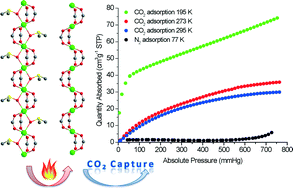
CrystEngComm, 2013,15, 9688-9693
https://doi.org/10.1039/C3CE41106K
Structural diversity and fluorescent properties of CdII coordination polymers with 5-halonicotinates regulated by solvent and ligand halogen-substituting effect
Seven CdII coordination polymers with a pair of 5-halonicotinic acids are presented, which display diverse polymeric structures to reveal the significant solvent and ligand halogen-substituting effect.
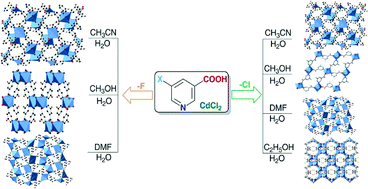
CrystEngComm, 2013,15, 9713-9721
https://doi.org/10.1039/C3CE41116H
Using hinged ligands to target structurally flexible copper(II) MOFs
A change from a 2-D to a 3-D MOF structure, which both incorporate structurally similar metal nodes, is engineered by incorporating additional steric bulk onto the ligand backbone.
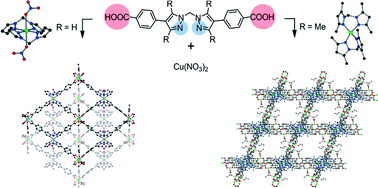
CrystEngComm, 2013,15, 9663-9671
https://doi.org/10.1039/C3CE41244J
Retention of Cs–Cl bond induces coordination polymer formation over trinuclear chiral assembly of copper(II) complexes of L-leucine derived ligand
Out of several ionic salts, potassium halides, CsCl and CsNO3, only CsCl behaves differently in an assembly formation reaction, retaining the CsCl bond intact in the product.
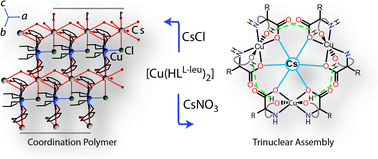
CrystEngComm, 2013,15, 9648-9654
https://doi.org/10.1039/C3CE41070F
Direct synthesis and mechanism of the formation of mixed metal Fe2Ni-MIL-88B
Phase evolution and importance of anion in the synthesis of MIL-88B and why chloride is needed are reported.
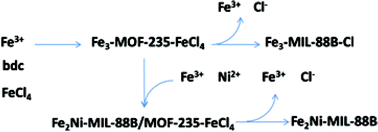
CrystEngComm, 2013,15, 9694-9703
https://doi.org/10.1039/C3CE41453A
Bifunctional pyrazolate–carboxylate ligands for isoreticular cobalt and zinc MOF-5 analogs with magnetic analysis of the {Co4(μ4-O)} node
MOF-5 analogs have been synthesized with ligands combining a pyrazolate and carboxylate functionality. These porous Metal–Azolate–Carboxylate (MAC) frameworks have the same cubic pcu-a topology and {M4(μ4-O)} nodes (M = Co, Zn) as IRMOFs. Small pore apertures and narrow pores yield a H2 and CO2 uptake higher than MOF-5.
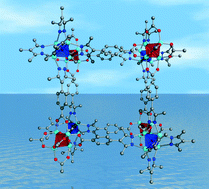
CrystEngComm, 2013,15, 9757-9768
https://doi.org/10.1039/C3CE41426D
Coordination polymers via self-assembly of silver(I) and cis-bis-nitrile-oxa-bowl derivatives
Self-assembly structures of AgCPs strongly depend on conformational restriction and steric bulk of oxa-bowl ligands and counter anions.
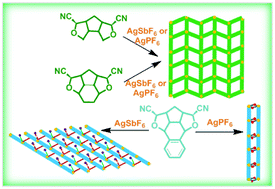
CrystEngComm, 2013,15, 9623-9633
https://doi.org/10.1039/C3CE41003J
M(II) (M = Mn, Co, Ni) variants of the MIL-53-type structure with pyridine-N-oxide as a co-ligand
Metal–organic frameworks with structures related to the MIL-53 framework have been crystallised for divalent metals and mixtures of metals.
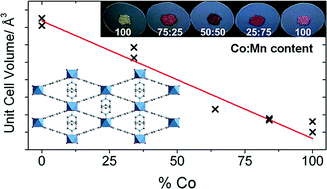
CrystEngComm, 2013,15, 9679-9687
https://doi.org/10.1039/C3CE41268G
Relating pore hydrophilicity with vapour adsorption capacity in a series of amino acid based metal organic frameworks
A new amino acid based homochiral MOF has been synthesized and comparisons with its earlier congeners show an exciting structure–property relationship.
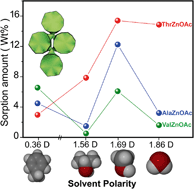
CrystEngComm, 2013,15, 9634-9640
https://doi.org/10.1039/C3CE41083H
Manganese(II) and copper(II) nitrate bis-imidazole coordination polymers: dimensionality and product morphology
Choice of metal and hence dimensionality of coordination polymers influences morphology of rapidly precipitated particles.
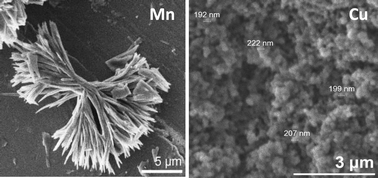
CrystEngComm, 2013,15, 9704-9712
https://doi.org/10.1039/C3CE41082J
Coordination polymers of a dipyridylazacrown ligand: structural, thermal and spectroscopic properties
In a series of 2D (4,4) sheet coordination polymers a dipyridylazacrown ether variable length ligand shows a remarkably consistent adoption of the S-configuration when empty or singly protonated with a water guest, with bridging lengths varying by only 1.3 Å.
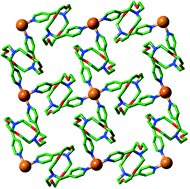
CrystEngComm, 2013,15, 9655-9662
https://doi.org/10.1039/C3CE41202D
Crystallisation of solvothermally synthesised ZIF-8 investigated at the bulk, single crystal and surface level
Parallel monitoring at the bulk, single crystal and surface level provide unique insight into the solvothermal crystallisation, and potential control over the crystal properties, of ZIF-8.
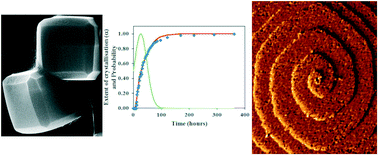
CrystEngComm, 2013,15, 9672-9678
https://doi.org/10.1039/C3CE40943K
A supramolecular dual-host based ion-pair induced formation of 1D coordination polymer
An N-bridged tripodal urea receptor (L1) in combination with 18-crown-6-ether (LC) has been structurally authenticated to self-assemble into an integrated 1D coordination polymer in the presence of potassium carbonate (K2CO3).
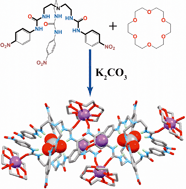
CrystEngComm, 2013,15, 9641-9647
https://doi.org/10.1039/C3CE41054D
Alkali-metal-regulated construction of superhydrophilic ZnII and CdII coordination polymers with perhalogenated terephthalate ligands
By using alkali metal ions as structure-directing agents, four diverse superhydrophilic coordination polymers with perhalogenated terephthalates were prepared, which will be converted to new complexes via recrystallizating in water.
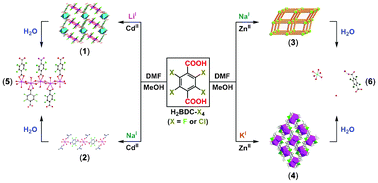
CrystEngComm, 2013,15, 9613-9622
https://doi.org/10.1039/C3CE41108G
Sr2+ and Cd2+ coordination polymers : the effect of the different coordinating behaviour of a newly designed tricarboxylic acid
Two new CPs based on Sr2+ and Cd2+ have been synthesized using a new tricarboxylic acid ligand with 3D and 1D structures, and their photoluminescence behavior has been studied.
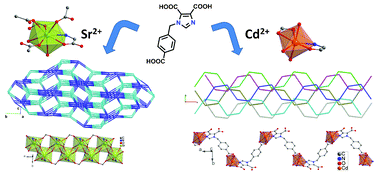
CrystEngComm, 2013,15, 9596-9602
https://doi.org/10.1039/C3CE41080C
Impact of functionalized linkers on the energy landscape of ZIFs
Attractive interactions between methyl groups of imidazolate linkers (visualized here through a Non covalent interaction analysis) play an important role in the energy landscape of zeolitic imidazolate frameworks.

CrystEngComm, 2013,15, 9603-9612
https://doi.org/10.1039/C3CE41103F
Syntheses, structures and characteristics of four metal–organic coordination polymers based on 5-hydroxyisophthalic acid and N-containing auxiliary ligands
Four metal–organic coordination polymers based on 5-hydroxyisophthalic acid and various N-containing ligands were synthesized and characterized.
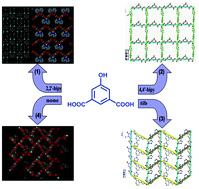
CrystEngComm, 2013,15, 9578-9587
https://doi.org/10.1039/C3CE41035H
Structure diversities of ten entangled coordination polymers assembled from reactions of Co(II) or Ni(II) salts with 5-(pyridin-4-yl)isophthalic acid in the absence or presence of auxiliary N-donor ligands
Reactions of Co(II) or Ni(II) salts with 5-(pyridin-4-yl)isophthalic acid in the absence or presence of auxiliary N-donor ligands afforded ten entangled coordination polymers.
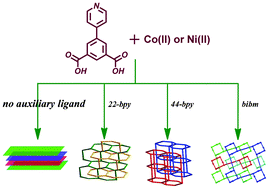
CrystEngComm, 2013,15, 9553-9561
https://doi.org/10.1039/C3CE41059E
Structural design of porous coordination networks from tetrahedral building units
Eight MOFs constructed from a synthetically-accessible tetrahedral ligand were structurally and topologically analyzed.
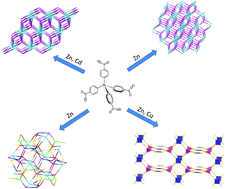
CrystEngComm, 2013,15, 9544-9552
https://doi.org/10.1039/C3CE41105B
Tailoring of network dimensionality and porosity adjustment in Zr- and Hf-based MOFs
The monocarboxylic acid (so called modulator) behaves as a structure directing agent during the synthesis of MOFs containing Zr6O8 cluster and decreases the connectivity of the SBU from 12 to 8 and even to 6. Hence three different porous MOFs could be synthesised.
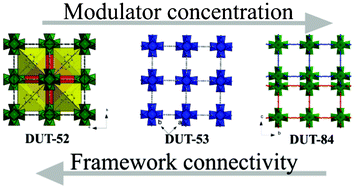
CrystEngComm, 2013,15, 9572-9577
https://doi.org/10.1039/C3CE41121D
pH-Dependent cobalt(II) frameworks with mixed 3,3′,5,5′-tetra(1H-imidazol-1-yl)-1,1′-biphenyl and 1,3,5-benzenetricarboxylate ligands : synthesis, structure and sorption property
Three cobalt(II) frameworks with different structures and colours were obtained by tuning pH values of reaction solution.
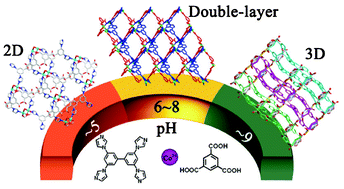
CrystEngComm, 2013,15, 9537-9543
https://doi.org/10.1039/C3CE41056K
Indium metal–organic frameworks as catalysts in solvent -free cyanosilylation reaction
Indium MOFs as the catalyst in the cyanosilylation of carbonyl compounds following a two-component system mechanism.
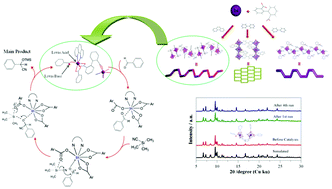
CrystEngComm, 2013,15, 9562-9571
https://doi.org/10.1039/C3CE41123K
Two new polar coordination polymers with diamond networks: interpenetration and thermal phase transition
In the two diamond networks, one has a rare reversible phase transition between a racemic-twinning chiral and a non-twinning noncentrosymmetric structure.
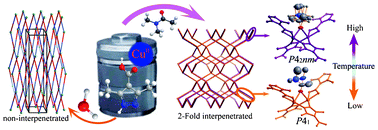
CrystEngComm, 2013,15, 9530-9536
https://doi.org/10.1039/C3CE41111G
Computational design of metal–organic frameworks for aniline recovery from aqueous solution
Several novel MOFs were computationally designed which show a high performance for aniline recovery from aqueous solution.
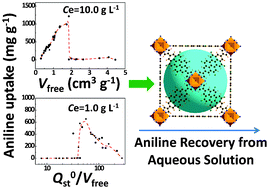
CrystEngComm, 2013,15, 9588-9595
https://doi.org/10.1039/C3CE41081A
About this collection
This themed issue highlights research towards understanding the factors that drive and influence the aggregation of small molecules, by means of metal to ligand coordination, to yield coordination polymers and metal-organic frameworks.